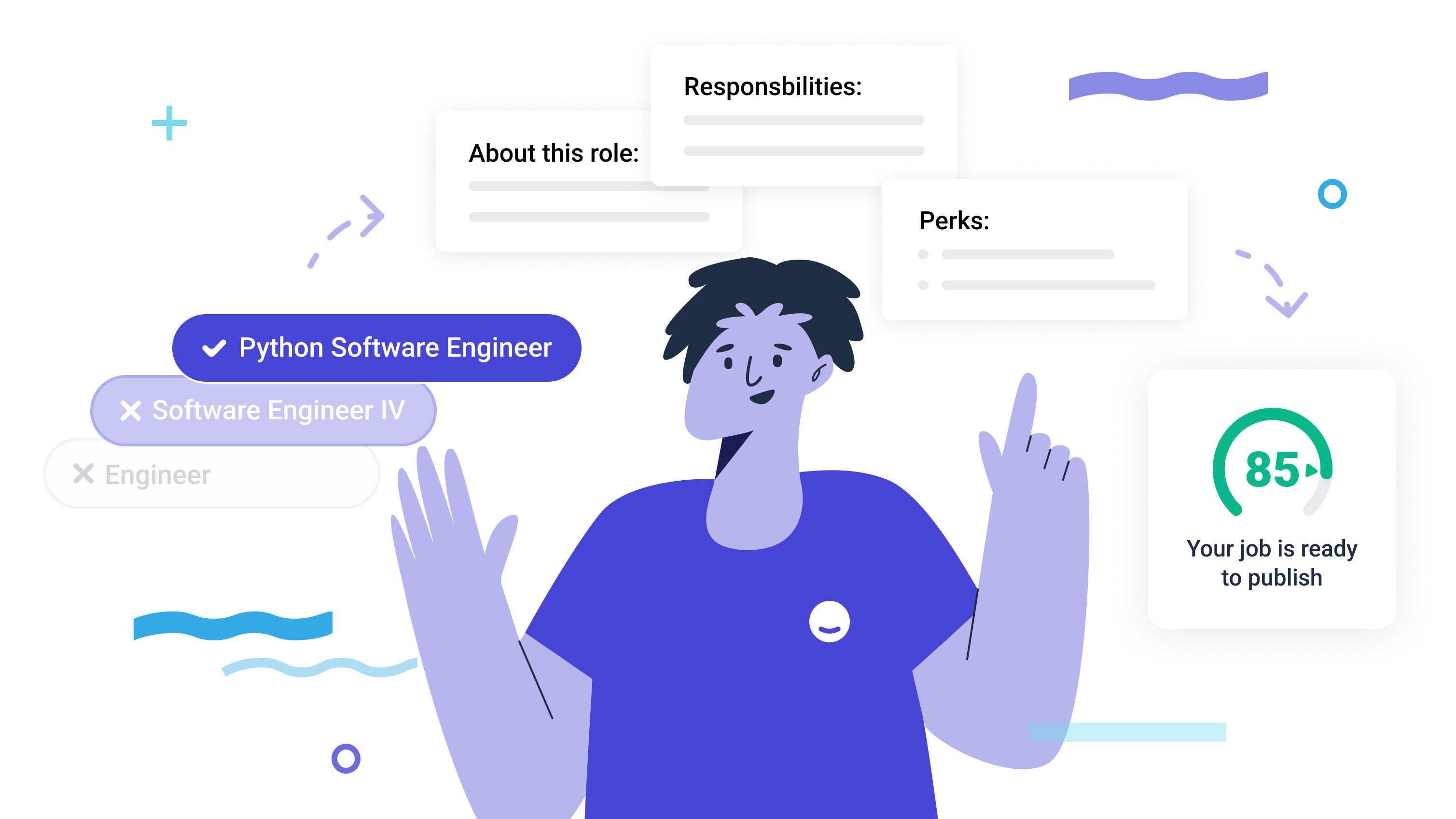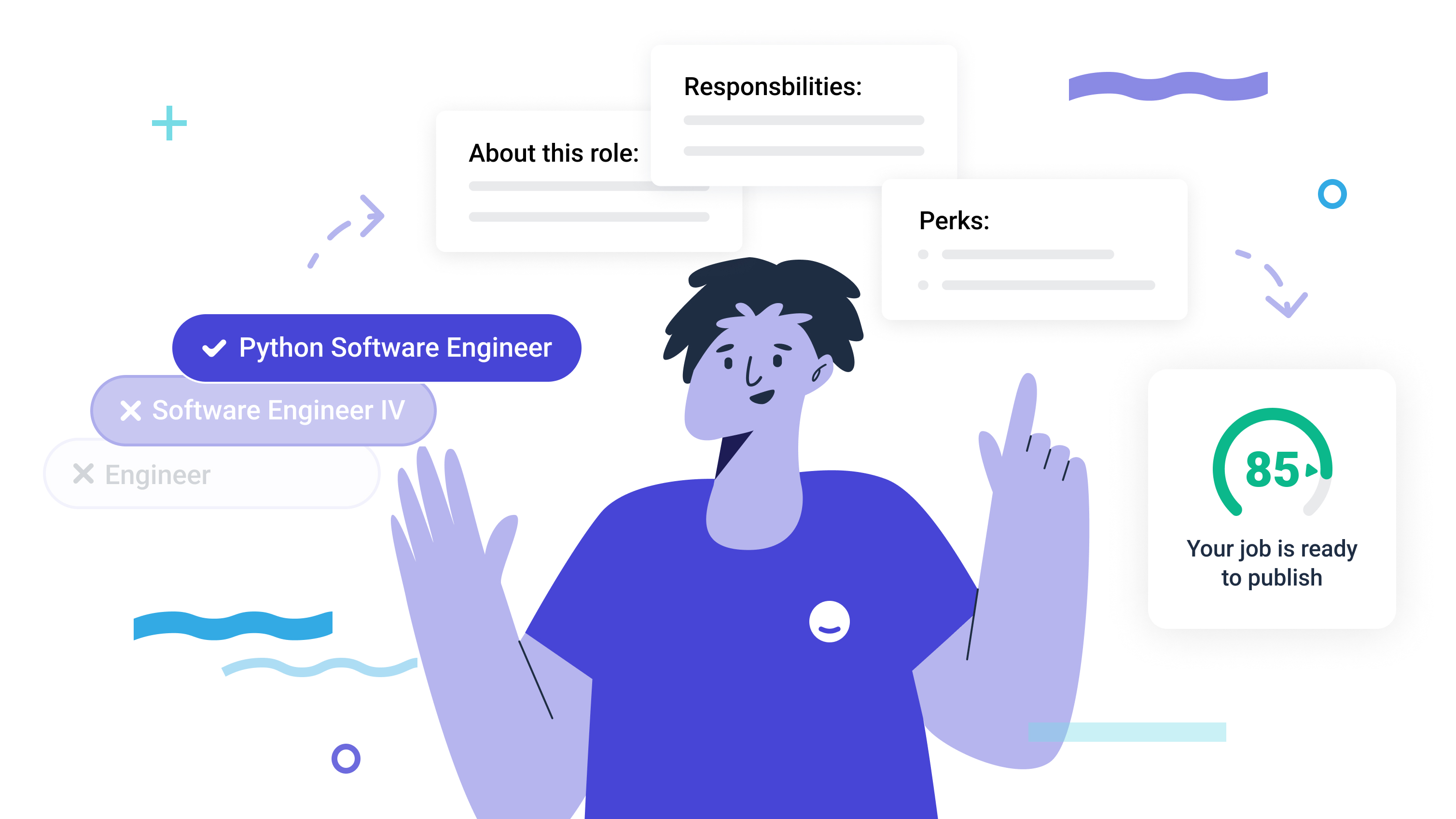Inclusive job descriptions ensure that all qualified job seekers feel comfortable applying, no matter their skin color, gender, sexual orientation, or anything else. But they’re not an accident.


Inclusive job descriptions employ non-biased job description language, diversity statements, clear requirements, benefits and perks, and widespread publication. They ensure that all qualified job seekers feel comfortable applying. No matter the color of their skin, their gender, sexual orientation, accent, or anything else.
So what makes job descriptions inclusive? And how do you know yours are welcoming to folks of all stripes? Start by following these five steps.
1. Choose a searchable, industry-standard title that job seekers can find and recognize.
2. Be absolutely clear about the role, the responsibilities, and the requirements.
3. Authentically represent your company and culture by adding diversity statements and benefits/perks sections.
4. Use clear, non-biased language that welcomes job seekers of all backgrounds.
5. Publish your job ad everywhere job seekers are looking for it.
1. Choose a searchable, industry-standard title that job seekers can find and recognize.
The job title you use on a job post isn’t just an aesthetic or organizational choice. When it comes to external use (i.e., job ads), job titles have a different function. Inclusive job descriptions include titles that are easy to find and recognize.
A job title is the focal point where hiring teams, job seekers, and job boards all first connect. Hiring teams use titles to define and categorize roles. Job seekers use titles as keywords to search for work on job boards. And job boards use titles as keywords to show listings to job seekers on their sites.
Industry-standard titles are crucial. Use industry-standard titles as opposed to internal titles; so, Java Developer, not Java Ninja. Describe the area of expertise; so, Python Software Engineer, not Software Engineer. (And definitely not just Engineer ─ there are dozens of engineering positions.) Keep titles short (between four to six words) so they don’t confuse and deter job seekers (or get truncated by job search engines). And skip the internal leveling indicators (e.g., Java Developer II).
Also, don’t inflate the title unnecessarily. Instead of Senior Java Developer if the job only requires two years of experience, just Java Developer. Our own research shows that inflating a job title can negatively impact your applicant funnel.
In a recent study of financial analyst titles, we found that job titles including the word ‘Senior’ in them attracted fewer applicants on average. They attracted 29% fewer applicants overall, 39% fewer qualified applicants, and 27% fewer female applicants.
Finally, include a location for your job because job boards use location to determine search results. Always include the city and state in the location field, and include ‘or Remote’ if you’re hiring for remote work. Meanwhile, never include vague locations like ‘Headquarters’ or ‘Warehouse.’
2. Be absolutely clear about the role, the responsibilities, and the requirements.
The closer a job description matches the actual job, the more qualified applicants it’s likely to attract. Conversely, the less a job description matches the job…well, the more time your hiring team will spend sifting through applications or sourcing candidates on LinkedIn.
Inclusive job descriptions are crystal clear on what a person does in a role, whom they report to, and what skills and abilities they need to succeed. And they should stick closely to that list.
Make sure your requirements match the job. Otherwise, you could deter qualified candidates and attract unqualified candidates. Don’t inflate the job with unnecessary education qualifications or certifications, dump a laundry list of nice-to-haves in there, include conflicting skills, or list soft skills that don’t actually tell job seekers anything. Keep it concise and clear.
Also, remember the difference between job responsibilities and job requirements. Responsibilities are the functions an employee will perform. Requirements are the certifications, education, skills, et cetera that an applicant needs to already have in order to step into the role.
Start with responsibilities when writing job descriptions. Figure out exactly what the person will need to do. Be specific. After that, figure out what skills the person will need to be able to fulfill those responsibilities.
3. Authentically represent your company and culture by adding diversity statements and benefits/perks sections.
Savvy job seekers don’t assume your company will do right by them. They want to read─in writing─exactly what you offer employees. And while diversity, equity, and inclusion (DEI) statements, benefits, and perks may seem like standard fare, don’t assume job seekers think your company has their best interests at heart.
Basically, a job description with no commitment in writing leaves job seekers with questions. They may not feel comfortable applying. But job descriptions that include diversity statements, full benefits, and useful perks like tuition reimbursement is reassuring. They know that your company offers the critical things they need.
In another study, we were curious about the impact of diversity statements on job posts. Do job seekers care whether companies include diversity statements? The short answer is yes: DEI statements can increase perceived inclusiveness. Just having them on job posts make jobs and employers seem more inclusive.
4. Use clear, non-biased job description language that welcomes all job seekers.
Job seekers find jargon, wordiness, or awkwardness in job posts confusing, while they understand concise, clear language just fine. Similarly, some sentiments are welcoming to everyone, while others are welcoming only to certain folks.
Clear job description language
First, job description language is often the first or only messaging a job seeker sees from your company, so it has to be clear. Particularly about the specific responsibilities and requirements necessary to succeed in the position. It also has to be concise ─ only as long as necessary.
Jargon and cliches are confusing for all job seekers, qualified and unqualified alike. Reading them, qualified applicants may not think they qualify while unqualified applicants may think they do. The result is fewer qualified applicants in your pipeline and more unqualified applicants, which doesn’t help your bottom line.
Soft skills, while highly valued by hiring teams and included in most job posts, present a similar problem as jargon and cliches. Again, fewer qualified applicants in the pipeline and more unqualified ones. Which makes job description language a bad place to assess soft skills when compared to the interview process.
Job seekers not only have to determine exactly what ‘excellent communication’ means, but they also have to gauge their own proficiency. An excellent communicator may think they’re not good enough, or a so-so communicator may think they are.
For clarity, skip the jargon, cliches, and soft skills. Also, speak to job seekers in active voice (e.g., ‘Billy threw the ball,’ not ‘The ball was thrown by Billy’). And avoid sales pitches and third-person addresses (e.g., ‘You will…,’ not ‘The right candidate will…’).
Inclusive job description language
For inclusivity, use non-biased sentiments and phrases in your job description language. The goal is to have a message that doesn’t deter anyone, no matter their background. However, don’t turn to an inclusive language guide.
Inclusive language is tricky to identify without research and bias guidance because there are so many forms of bias that can creep into job description language. They include racism, tokenism, ableism, ageism, sexism, nationalism, religion bias, and elitism.
An inclusive language guide is too simplistic to help because it oversimplifies job description language. It provides a list of supposedly ‘inclusive’ and ‘exclusive’ words. However, language is more complex than that, with many factors unique to each individual job seeker coming into play. And it’s not just the words, it’s the sentiment behind the words that matter.
Naturally, it’s impossible for a recruiter to put themselves into the shoes of absolutely every person out there. Thankfully, a job description editor with research baked into its guidance can help.
5. Publish your job ad everywhere job seekers are looking for it.
Your hiring team works really hard to get a job description just right. You have a searchable title, clear responsibilities and requirements, benefits and perks info, and inclusive language. You publish it on your website and wait for someone to find it. And wait, and wait, and wait.
It doesn’t matter how hard your hiring team works to get a job description right if no qualified candidates ever see it. And it’s not enough to publish it on your website or to a single job board and hope for the best. Job seekers have way too many options when it comes to job hunting on the internet.
Widespread dissemination is the name of the game here. Only companies with major brand recognition can rely on job seekers coming to their websites. Everyone else has to spread the word far and wide. (That’s actually one of the things that inclusive job descriptions should do: introduce your company to a wide audience.)
Publish your job to all major job boards, niche job boards, and even social media. If you’re hiring for a remote worker, check out job boards designed for remote hiring (e.g., FlexJobs). If you’re hiring a software engineer, don’t neglect the job boards set up specifically for them (e.g., Python.org).
But don’t just “spray and pray” - make sure to monitor your sourcing channels (especially paid ones, like LinkedIn) to gauge return on investment and optimize toward those attracting qualified candidates and hires.
Finally, include a location for your job because job boards use location to determine search results. Always include the city and state in the location field, and include ‘or Remote’ if you’re hiring for remote work. Meanwhile, never include vague locations like ‘Headquarters’ or ‘Warehouse.’
5 steps to inclusive job descriptions
Include everyone and exclude no one: that’s the goal of inclusive job descriptions. It means using common job titles, clear requirements that match the job, and standard-but-reassuring content. It also means using unbiased language and publishing your job descriptions everywhere you can.
